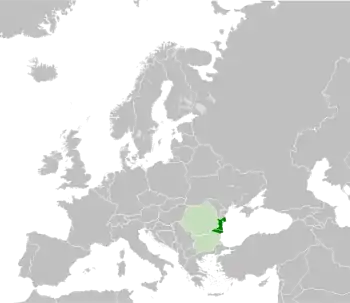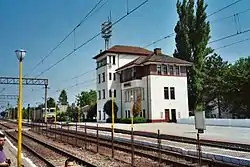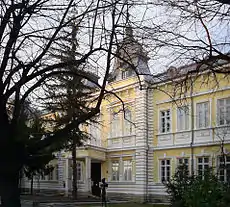دوبروجا
دوبروجا (بلغاری: Добруджа, ترجمه: Dobrudzha یا Dobrudža; رومانیایی: Dobrogea تلفظ [ˈdobrod͡ʒe̯a] (![]() شنیدن) یا [doˈbrod͡ʒe̯a]; ترکی استانبولی: Dobruca) یک منطقه تاریخی بودهاست.
شنیدن) یا [doˈbrod͡ʒe̯a]; ترکی استانبولی: Dobruca) یک منطقه تاریخی بودهاست.
این منطقه در قرن ۱۹ میلادی بین کشورهای رومانی و بلغارستان تقسیم شدهاست، دوبروجا که در کنار دریای سیاه قرار داشته و رود دانوب از میان آن میگذرد بخش شمالی رود متعلق به رومانی و بخش جنوبی آن متعلق به بلغارستان میباشد.
بخش رومانیایی دوبروجا شامل شهرستان کنستانتسا و شهرستان تولچا و ۱۵٬۵۰۰ کیلومتر مربع مساحت و جمعیتی کمتر از ۹۰۰ هزار نفر میباشد.
بخش بلغارستانی دوبروجا شامل استان دوبریچ و استان سیلیسترا و ۷٬۵۶۵ کیلومتر مربع مساحت و جمعیتی در حدود ۳۱۰٬۰۰۰ نفر است.
تاریخ جمعیتشناسی
دوبروجا شمالی
| قومیت | 1878[1] | 1880[2] | 1899[2] | 1913[3] | 19301[4] | 1956[5] | 1966[5] | 1977[5] | 1992[5] | 2002[5] | 2011[6] |
|---|---|---|---|---|---|---|---|---|---|---|---|
| تمام | ۲۲۵٬۶۹۲ | ۱۳۹٬۶۷۱ | ۲۵۸٬۲۴۲ | ۳۸۰٬۴۳۰ | ۴۳۷٬۱۳۱ | ۵۹۳٬۶۵۹ | ۷۰۲٬۴۶۱ | ۸۶۳٬۳۴۸ | ۱٬۰۱۹٬۷۶۶ | ۹۷۱٬۶۴۳ | ۸۹۷٬۱۶۵ |
| رومانیایی | ۴۶٬۵۰۴ (۲۱٪) | ۴۳٬۶۷۱ (۳۱٪) | ۱۱۸٬۹۱۹ (۴۶٪) | ۲۱۶٬۴۲۵ (۵۶٫۸٪) | ۲۸۲٬۸۴۴ (۶۴٫۷٪) | ۵۱۴٬۳۳۱ (۸۶٫۶٪) | ۶۲۲٬۹۹۶ (۸۸٫۷٪) | ۷۸۴٬۹۳۴ (۹۰٫۹٪) | ۹۲۶٬۶۰۸ (۹۰٫۸٪) | ۸۸۳٬۶۲۰ (۹۰٫۹٪) | ۷۵۱٬۲۵۰ (۸۳٫۷٪) |
| بلغار | ۳۰٬۱۷۷ (۱۳٫۳٪) | ۲۴٬۹۱۵ (۱۷٪) | ۳۸٬۴۳۹ (۱۴٪) | ۵۱٬۱۴۹ (۱۳٫۴٪) | ۴۲٬۰۷۰ (۹٫۶٪) | ۷۴۹ (۰٫۱۳٪) | ۵۲۴ (۰٫۰۷٪) | ۴۱۵ (۰٫۰۵٪) | ۳۱۱ (۰٫۰۳٪) | ۱۳۵ (۰٫۰۱٪) | ۵۸ (۰٫۰۱٪) |
| ترک | ۴۸٬۷۸۳ (۲۱٫۶٪) | ۱۸٬۶۲۴ (۱۳٪) | ۱۲٬۱۴۶ (۴٪) | ۲۰٬۰۹۲ (۵٫۳٪) | ۲۱٬۷۴۸ (۵٪) | ۱۱٬۹۹۴ (۲٪) | ۱۶٬۲۰۹ (۲٫۳٪) | ۲۱٬۶۶۶ (۲٫۵٪) | ۲۷٬۶۸۵ (۲٫۷٪) | ۲۷٬۵۸۰ (۲٫۸٪) | ۲۲٬۵۰۰ (۲٫۵٪) |
| تاتار | ۷۱٬۱۴۶ (۳۱٫۵٪) | ۲۹٬۴۷۶ (۲۱٪) | ۲۸٬۶۷۰ (۱۱٪) | ۲۱٬۳۵۰ (۵٫۶٪) | ۱۵٬۵۴۶ (۳٫۶٪) | ۲۰٬۲۳۹ (۳٫۴٪) | ۲۱٬۹۳۹ (۳٫۱٪) | ۲۲٬۸۷۵ (۲٫۶۵٪) | ۲۴٬۱۸۵ (۲٫۴٪) | ۲۳٬۴۰۹ (۲٫۴٪) | ۱۹٬۷۲۰ (۲٫۲٪) |
| روس-لیپووان | ۱۲٬۷۴۸ (۵٫۶٪) | ۸٬۲۵۰ (۶٪) | ۱۲٬۸۰۱ (۵٪) | ۳۵٬۸۵۹ (۹٫۴٪) | 26,210 (6%)2 | ۲۹٬۹۴۴ (۵٪) | ۳۰٬۵۰۹ (۴٫۳۵٪) | ۲۴٬۰۹۸ (۲٫۸٪) | ۲۶٬۱۵۴ (۲٫۶٪) | ۲۱٬۶۲۳ (۲٫۲٪) | ۱۳٬۹۱۰ (۱٫۶٪) |
| روثنیا (اوکراینی از ۱۹۵۶) |
۴۵۵ (۰٫۳٪) | ۱۳٬۶۸۰ (۵٪) | ۳۳ (۰٫۰۱٪) | ۷٬۰۲۵ (۱٫۱۸٪) | ۵٬۱۵۴ (۰٫۷۳٪) | ۲٬۶۳۹ (۰٫۳٪) | ۴٬۱۰۱ (۰٫۴٪) | ۱٬۴۶۵ (۰٫۱٪) | ۱٬۱۷۷ (۰٫۱٪) | ||
| آلمانیهای دوبروجا | ۱٬۱۳۴ (۰٬۵٪) | ۲٬۴۶۱ (۱٫۷٪) | ۸٬۵۶۶ (۳٪) | ۷٬۶۹۷ (۲٪) | ۱۲٬۰۲۳ (۲٫۷۵٪) | ۷۳۵ (۰٫۱۲٪) | ۵۹۹ (۰٫۰۹٪) | ۶۴۸ (۰٫۰۸٪) | ۶۷۷ (۰٫۰۷٪) | ۳۹۸ (۰٫۰۴٪) | ۱۶۶ (۰٫۰۲٪) |
| یونانی | ۳٬۴۸۰ (۱٫۶٪) | ۴٬۰۱۵ (۲٫۸٪) | ۸٬۴۴۵ (۳٪) | ۹٬۹۹۹ (۲٫۶٪) | ۷٬۷۴۳ (۱٫۸٪) | ۱٬۳۹۹ (۰٫۲۴٪) | ۹۰۸ (۰٫۱۳٪) | ۶۳۵ (۰٫۰۷٪) | ۱٬۲۳۰ (۰٫۱۲٪) | ۲٬۲۷۰ (۰٫۲۳٪) | ۱٬۴۴۷ (۰٫۱۶٪) |
| رومی | ۷۰۲ (۰٫۵٪) | ۲٬۲۵۲ (۰٫۸۷٪) | ۳٬۲۶۳ (۰٫۹٪) | ۳٬۸۳۱ (۰٫۸۸٪) | ۱٬۱۷۶ (۰٫۲٪) | ۳۷۸ (۰٫۰۵٪) | ۲٬۵۶۵ (۰٫۳٪) | ۵٬۹۸۳ (۰٫۵۹٪) | ۸٬۲۹۵ (۰٫۸۵٪) | ۱۱٬۹۷۷ (۱٫۳٪) |
- 1According to the 1926–1938 Romanian administrative division (counties of شهرستان کنستانتسا and شهرستان تولچا), which excluded a part of today's Romania (chiefly the communes of Ostrov and Lipnița, now part of شهرستان کنستانتسا) and included a part of today's Bulgaria (parts of شهرستان جنرال توشوو and شهرستان کروشاری municipalities)
- 2Only Russians. (Russians and Lipovans counted separately)
دوبروجا جنوبی
| قومیت | ۱۹۱۰ | 19301[4] | 2001[7] | 2011[8] |
|---|---|---|---|---|
| تمام | ۲۸۲٬۰۰۷ | ۳۷۸٬۳۴۴ | ۳۵۷٬۲۱۷ | 283,3953 |
| بلغار | ۱۳۴٬۳۵۵ (۴۷٫۶٪) | ۱۴۳٬۲۰۹ (۳۷٫۹٪) | ۲۴۸٬۳۸۲ (۶۹٫۵٪) | ۱۹۲٬۶۹۸ (۶۸٪) |
| ترک | ۱۰۶٬۵۶۸ (۳۷٫۸٪) | ۱۲۹٬۰۲۵ (۳۴٫۱٪) | ۷۶٬۹۹۲ (۲۱٫۶٪) | ۷۲٬۹۶۳ (۲۵٫۷۵٪) |
| رومی | ۱۲٬۱۹۲ (۴٫۳٪) | ۷٬۶۱۵ (۲٪) | ۲۵٬۱۲۷ (۷٪) | ۱۲٬۱۶۳ (۴٫۲۹٪) |
| تاتار | ۱۱٬۷۱۸ (۴٫۲٪) | ۶٬۵۴۶ (۱٫۷٪) | ۴٬۵۱۵ (۱٫۳٪) | ۸۰۸ (۰٫۲۹٪) |
| رومانیایی | 6,348 (2.3%)2 | ۷۷٬۷۲۸ (۲۰٫۵٪) | 591 (0.2%)2 | ۹۴۷ (۰٫۳۳٪) |
- 1According to the 1926–1938 Romanian administrative division (counties of Durostor و Caliacra), which included a part of today's Romania (chiefly the communes of Ostrov and Lipnița, now part of شهرستان کنستانتسا) and excluded a part of today's Bulgaria (parts of شهرستان جنرال توشوو and شهرستان کروشاری municipalities)
- 2Including persons counted as ولاک in Bulgarian Census
- 3Only includes persons who answered the optional question on ethnic identity. The total population was 309,151.
جمعیت و شهرها
| قومیت | دوبروجا | دوبروجا رومانی[6] | دوبروجا بلغارستان[8] | |||
|---|---|---|---|---|---|---|
| جمعیت | درصد | جمعیت | درصد | جمعیت | درصد | |
| تمام | ۱٬۱۸۰٬۵۶۰ | ۱۰۰٫۰۰٪ | ۸۹۷٬۱۶۵ | ۱۰۰٫۰۰٪ | ۲۸۳٬۳۹۵ | ۱۰۰٫۰۰٪ |
| رومانیایی | ۷۵۲٬۱۹۷ | ۶۳٫۷۲٪ | ۷۵۱٬۲۵۰ | ۸۳٫۷۴٪ | ۹۴۷ | ۰٫۳۳٪ |
| بلغار | ۱۹۲٬۷۵۶ | ۱۶٫۳۳٪ | ۵۸ | ۰٫۰۱٪ | ۱۹۲٬۶۹۸ | ۶۸٪ |
| ترک | ۹۵٬۴۶۳ | ۸٫۰۹٪ | ۲۲٬۵۰۰ | ۲٫۵۱٪ | ۷۲٬۹۶۳ | ۲۵٫۷۵٪ |
| تاتار | ۲۰٬۵۲۸ | ۱٫۷۴٪ | ۱۹٬۷۲۰ | ۲٫۲۰٪ | ۸۰۸ | ۰٫۲۹٪ |
| رومی | ۲۴٬۱۴۰ | ۲٫۰۴٪ | ۱۱٬۹۷۷ | ۱٫۳۳٪ | ۱۲٬۱۶۳ | ۴٫۲۹٪ |
| روس | ۱۴٬۶۰۸ | ۱٫۲۴٪ | ۱۳٬۹۱۰ | ۱٫۵۵٪ | ۶۹۸ | ۰٫۲۵٪ |
| اوکراینی | ۱٬۲۵۰ | ۰٫۱۱٪ | ۱٬۱۷۷ | ۰٫۱۳٪ | ۷۳ | ۰٫۰۳٪ |
| یونانی | ۱٬۴۶۷ | ۰٫۱۲٪ | ۱٬۴۴۷ | ۰٫۱۶٪ | ۲۰ | ۰٫۰۱٪ |
شهرهای بزرگ کنستانتسا، تولچا، مدجیجا و منگلیا در رومانی، و دوبریچ و سیلیسترا در بلغارستان.
نگارخانه
جستارهای وابسته
پانویس
- K. Karpat, : Correspondance Politique des Consuls. Turguie (Tulqa). 1 (1878) 280-82
- G. Dănescu, Dobrogea (La Dobroudja). Étude de Géographie physique et ethnographique
- Roman, I. N. (1919). "La population de la Dobrogea. D'apres le recensement du 1er janvier 1913". In Demetrescu, A. La Dobrogea Roumaine. Études et documents (به French). Bucarest. OCLC 80634772.
- Calculated from results of the 1930 census per county, taken from Mănuilă, Sabin (1939). La Population de la Dobroudja (به French). Bucarest: Institut Central de Statistique. OCLC 1983592.
- Calculated from statistics for the counties of Tulcea and Constanța from "Populația după etnie la recensămintele din perioada 1930–2002, pe judete" (PDF) (به Romanian). Guvernul României — Agenţia Națională pentru Romi. pp. 5–6, 13–14. Retrieved 2007-05-02.
- 2011 census results per county, cities and towns "Populaţia stabilă pe sexe, după etnie – categorii de localităţi, macroregiuni, regiuni de dezvoltare şi judeţe" (XLS) (به Romanian). Institutul Național de Statistică. Retrieved 2015-11-20.
- Calculated from the results of the 2001 Bulgarian census for the administrative regions of Dobrich and Silistra, from "Население към 01.03.2001 г. по области и етническа група" (به Bulgarian). Националния статистически институт. Retrieved 2007-05-02.
- Calculated from the results of the 2011 Bulgarian census for the administrative regions of Dobrich and Silistra, from "Население по етническа група и майчин език" (به Bulgarian). Националния статистически институт. Archived from the original on 19 December 2015. Retrieved 2015-11-20.
منابع
- Dănescu, Grigore (1903). Dobrogea (La Dobroudja). Étude de Géographie physique et ethnographique (به French). Bucarest: Imprimerie de l'Indépendance Roumaine. OCLC 10596414.
- Ischirkoff, A. (1919). Les Bulgares en Dobroudja; aperçu historique et ethnographique (به French). Berne: Imprimerie Pochon-Jent & Bühler. OCLC 4061330.
- Wittek, Paul (1952). "Yazijioghlu 'Ali on the Christian Turks of the Dobruja". Bulletin of the School of Oriental and African Studies. Cambridge University Press on behalf of دانشکده مطالعات شرقی و آفریقایی. 14 (3): 639–668. doi:10.1017/S0041977X00088595. ISSN 0041-977X. JSTOR 609124.. Subscription needed for online access.
- Barnea, Ion; Ștefănescu, Ștefan (1971). Bizantini, romani și bulgari la Dunărea de Jos. Din Istoria Dobrogei (به Romanian). 3. Bucureşti: Editura Academiei Republicii Socialiste România. OCLC 1113905.
- Vaklinov, Stancho (1977). Формиране на старобългарската култура VI-XI век (به Bulgarian). Sofia: Издателство Наука и Изкуство. OCLC 71440284.
- Kuzev, Aleksandar; Gyuzelev, Vasil, eds. (1981). Градове и крепости но Дунава и Черно море. Български средновековни градове и крепости (به Bulgarian). 1. Varna: Книгоиздателство "Георги Бакалов". OCLC 10020724.
- Rădulescu, Adrian; Bitoleanu, Ion (1998). Istoria Dobrogei (به Romanian). Constanţa: Editura Ex Ponto. ISBN 978-973-9385-32-9.
- Mărculeţ, Vasile (2003). "Asupra organizării teritoriilor bizantine de la Dunărea de Jos în secolele X-XII: thema Mesopotamia Apusului, strategatul Dristrei, thema Paristrion – Paradunavon". In Dobre, Manuela. Istorie şi ideologie (به Romanian). București: Editura Universității din București. ISBN 978-973-575-658-1. Archived from the original on 18 April 2018. Retrieved 2007-04-29.
- Hitchins, Keith (2004). Romania 1866–1947 (به Romanian) (II ed.). București: Humanitas. ISBN 978-973-50-0551-1.
This article is issued from Wikipedia. The text is licensed under Creative Commons - Attribution - Sharealike. Additional terms may apply for the media files.




.jpg.webp)







